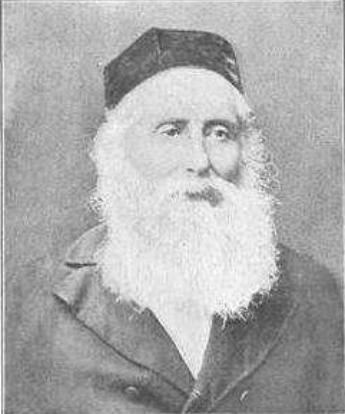Name Hayyim Slonimski | Children Leonid Ludwik Slonimski | |
 | ||
Died May 15, 1904, Warsaw, Poland | ||
Hayyim Selig Slonimski (Hebrew: חיים זעליג סלונימסקי, also known by his acronym CHaZaS) (March 31, 1810 – May 15, 1904) was a Hebrew publisher, astronomer, inventor, and science author.
Contents
Biography
Hayyim Selig Slonimski was born in Białystok, in the Grodno Governorate of the Russian Empire (present-day Poland) on March 31, 1810.
He pioneered the education of Jews in Eastern Europe in science; to do this, he introduced a vocabulary of technical terms created partly by himself into the Hebrew language. His reputation as a strictly orthodox rabbi assured fellow Jews that his scientific teachings would not undermine religion.
When Slonimski was only twenty-four years old he finished writing a textbook on mathematics, but due to lack of funds, only the first part of which was published in 1834 under the title Mosede Ḥokmah.
In 1835 Slonimski released Sefer Kukba di-Shebit (1835), a collection of essays on the Halley comet and other astronomy related topics such as laws of Kepler and Newton. This work significantly increased Slonimiski's popularity, because Halley's comet was widely discussed topic as the return of this periodic comet was expected in 1835.
In 1838 Hayyim Selig Slonimski settled in Warsaw, where he became acquainted with mathematician and inventor Abraham Jacob Stern (1768–1842), later becoming his son-in-law, when in 1842 he married Stern's youngest daughter, Sarah (1824–1897).
In 1842, Slonimski created a calculating machine, which he exhibited to the St. Petersburg Academy of Sciences; he was awarded the Demidov Prize of 2,500 roubles. In 1844, he published a formula in Crelle's Journal for calculating the Jewish calendar. It was a considerable improvement on anything published before. In 1853 he invented a chemical process for plating iron vessels with lead to prevent corrosion, and in 1856 a device for sending quadruple telegrams. The system of multiple telegraphy perfected by Lord Kelvin in 1858 was based on Slonimski's discovery.
In 1844 he was awarded the part Demidov Prize of 2,500 rubles by Russian Academy of Sciences for the invention of a calculating machine based on his tables. Slonimski lived between 1846 and 1858 in Tomaszów Mazowiecki, an industrial town in central Poland. In 1853 he invented a chemical process for plating iron vessels with lead, and in 1856 an electrochemical device for sending quadruple telegrams. The system of multiple telegraphy perfected by Lord Kelvin in 1858 was based on Slonimski's discovery In 1952, American newspapers ridiculed claims by Josef Stalin that Slonimsky had anticipated Americans in the development of the telegraph. However, his grandson, the musician Nicolas Slonimsky, was able to confirm some of Stalin's claims.
He corresponded with several scientists, notably Alexander von Humboldt, and wrote a sketch of Humboldt's life.
In deciding certain scientific questions connected with Jewish matters, Slonimski at times found himself at variance with other Jewish scholars. Thus, despite his conservatism, he admitted that an error of four days' excess had crept into the Hebrew calendar cycle as compared with the true solar cycle; in this view he was opposed especially by Joseph Perles, the controversy being carried on for thirty years. Slonimski likewise discussed the question of the so-called "Jewish date-line" for deciding on which days Shabbat and holy days should be observed by Jews in the Far East and in Australasia. He argued that for them the line must be fixed not from Greenwich, but from Jerusalem, the center of the earth according to the Talmud. This calculation would make the dividing line pass between China and Japan, the former with the Philippines being included in the Far East, and the latter in the West .
In 1862 in Warsaw Slonimski established weekly newspaper Ha-Tsefirah, which was the first Hebrew organ devoted mainly to scientific subjects. It was published for six months until the same year Slonimski was appointed as principal of the rabbinical seminary in Zhytomyr and as government censor of Hebrew books, positions which he held till the seminary was closed by the Russian government in 1874 .
Slonimski resumed the publication of Ha-Tsefirah at Berlin the same year, changing the place of publication to Warsaw in September 1875.
Hayyim Selig Slonimski died in Warsaw on May 15, 1904.
Zabłudów city council named a street after him.
The Stalin controversy
In 1952, Josef Stalin made a speech in which, among other things, he noted that Slonimsky had anticipated Americans in certain aspects of the development of the telegraph. This was ridiculed by the New York Times, which claimed that Stalin had invented Slonimsky. However, his grandson, the musicologist Nicolas Slonimsky, was able to confirm the accuracy of Stalin's claims.
